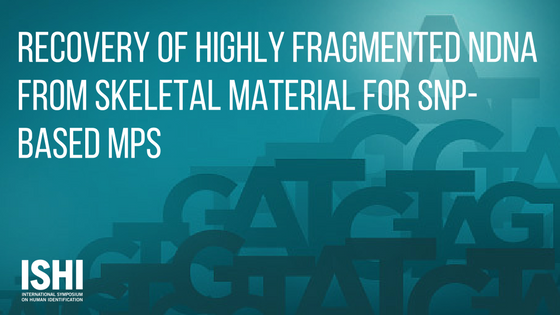The identification of skeletal remains that have been discovered after an extended period of time continues to be an important part of the fields of anthropology and forensic science. Due to the highly fragmented nature of the DNA recovered from more degraded skeletal remains, identification is not always possible with traditional techniques of mtDNA or STR analysis.
Submitted by: Elena Zavala, Pennsylvania State University
Single nucleotide polymorphism (SNP) analysis may be ideal for these types of samples as they can be typed through the targeting of shorter regions of DNA (40 to 70 bps). When multiple SNPs are typed simultaneously (~40 or more) they can be used for identity, and carefully selected SNPs can also provide phenotypic and ancestry information that would help with human identification.
Since current methods of DNA extraction in forensics have been optimized for recovery of larger fragment size suitable for STRs, for SNP typing it would be desirable to use methods optimized for recovery of the relatively abundant smaller fragments. This study aims to identify a scalable protocol for the recovery of DNA under 150bp in lengths and evaluate the performance of the ForenSeq system by Illumina with these types of samples.
In order to accomplish the above goal, three separate experiments were performed. First, pristine DNA was sheared to an average length of 150bp using a Covaris S2. This starting material was then used to perform a preliminary evaluation of four currently used DNA extraction protocols (Dabney, Rohland, ICMP and Yang).
From this preliminary evaluation, three different parameters were identified for further investigation: volume of digestion buffer during the demineralization phase, filter size during the concentration of demineralized supernatant, and the combination of binding buffer and silica column.
The first two parameters were evaluated with human bone. Five different binding buffers and two different silica columns were evaluated using the same sheared DNA as starting material. A second experiment was performed using starting material of demineralized animal bone spiked with the sheared pristine DNA in order to evaluate the impact of demineralized bone on the system. Finally, three of the binding buffers and the two columns were evaluated using human bone as the starting material.
Based on these experiments we identified an improved protocol for the recovery of highly fragmented DNA that combined aspects of both the current Yang and ICMP protocols. The implementation of this protocol will aid in the increased capacity for identification when working with highly degraded DNA in skeletal remains that may have been previously unidentifiable.
Protocol will aid in capacity for identification with highly degraded DNA in skeletal remains. Share on X
Next, we used the same sheared pristine DNA to evaluate begin evaluating the sensitivity of the ForenSeq system by Illumina for highly fragmented material. Preliminary results indicated potential in SNPs providing supplemental information for identification when there are limited typed STRs. This portion of the project is undergoing continued evaluation.
Key collaborators for this project included members of the International Commission on Missing Persons (Dr. Rene Huel and Dr. Sylvain Amory), anthropologists working in the ancient DNA field, as well Illumina.
My interest in this work stems from my interest in increasing the capacity of the forensic science community to successfully identify skeletal remains in missing person’s cases as well as mass disasters and mass graves. When addressing this aim as whole, the evaluation of currently used extraction protocol seemed to be a logical starting point. I plan to continue working in this area during my PhD studies.
WOULD YOU LIKE TO SEE MORE ARTICLES LIKE THIS? SUBSCRIBE TO THE ISHI BLOG BELOW!


